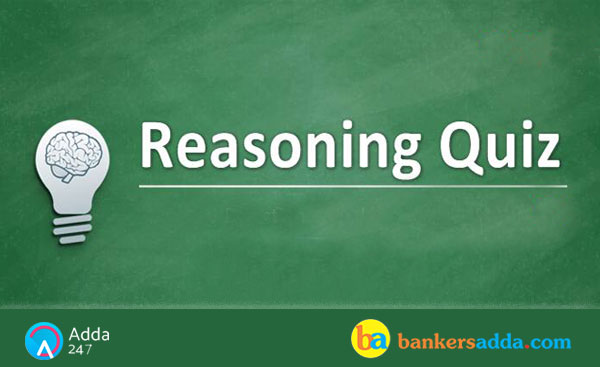Dear Aspirants,
Reasoning Ability is an onerous section. With the increasing complexity of questions, it becomes hard for one to give it the cold shoulder. Today is the Day 41 of the 60 Days SBI Clerk Prelims Study Plan. The only way to make the grade in this particular section in the forthcoming banking exams is to practice continuously with all your heart and soul. And, to let you practice with the best of the latest pattern questions, here is the Adda247 Reasoning Quiz based on the study plan and the exact same pattern of questions that are being asked in the exams.
Directions (1-5): In each of the questions below consists of a question and two statements numbered I and II given below it. You have to decide whether the data provided in the statements are sufficient to answer the question. Read both the statements and Give answer-
(a) If the data in statement I alone are sufficient to answer the question, while the data in statement II alone are not sufficient to answer the question.
(b) If the data in statement II alone are sufficient to answer the question, while the data in statement I alone are not sufficient to answer the question.
(c) If the data either in statement I alone or in statement II alone are sufficient to answer the question
(d) If the data given in both statements I and II together are not sufficient to answer the question.
(e) If the data in both statements I and II together are necessary to answer the question.
Q1. How is H related to J?
I. K, who has two children H and J and among them H is only son.
II. A is brother of J, who is mother of H.
Q2. Which train did Mahesh catch to go to office?
I. Mahesh missed his usual train of 5.17 p.m. A train comes in every 5 minutes.
II. Mahesh did not catch the 5.27 p.m. train or any train after that time.
Q3. How is Z related to X?
I. B’s sister D has married to Z’s brother G, who is the only son of his parents.
II. X is the only daughter of G and D.
Q4. How is Aman related to Sohan?
I. Aman is the grandson of Sohan’s father.
II. Sohan has no sisters but has several friends and each of his friends is the only son in his respective family.
Q5. In a certain code @# means ‘Mahesh Swati’ and $% means ‘Aman Ankita’. What do * and & mean respectively in that code?
I. @ * % means ‘Swati Sameer Aman’.
II. @ $ & means ‘Swati Raj Ankita’.
Directions (6-10): Study the following information to answer the given question.
In a certain code language,
‘century spectacular growth powered’ is written as ‘su da nic ki’,
‘internal powered combustion engine’ is written as ‘phi ra tic da’,
‘automobile engine growth industry’ is written as ‘tic gi ki mo’,
‘industry taking combustion century’ is written as ‘zo nic phi gi’.
Q6. What is the code for ‘spectacular’?
(a) da
(b) su
(c) nic
(d) ki
(e) Cannot be determined
Q7. Which of the following is the code for ‘internal industry growth’?
(a) zo ra ki
(b) ra su mo
(c) tic su ra
(d) ki ra gi
(e) None of these
Q8. What does ‘mo’ stand for?
(a) growth
(b) industry
(c) automobile
(d) combustion
(e) Cannot be determined
Q9. Which of the following is represented by the code ‘da phi nic’?
(a) Combustion engine century
(b) century powered taking
(c) century powered combustion
(d) combustion internal engine
(e) None of these
Q10. Which of the following may be the codes which represents ‘automobile finest industry’?
(a) mo gi nic
(b) ra gi da
(c) mo gi nop
(d) mo zo phi
(e) None of these
Directions (11-15): In these questions, relationship between different elements is shown in the statements. These statements are followed by three/four conclusions. Read the statements and the decide which of the following conclusions follow from the given statements.
Q11. Statements: P<A≤N,P>T,M≤A<S
Conclusions: I. S>P II. T<A
III. N>T IV. S>N
(a) Only I and II follow
(b) Only III and IV follow
(c) Only I, II and III follow
(d) Only I and IV follow
(e) All follow
Q12. Statements: P≥R<S≥M>E≥B
Conclusions: I. E<S II. B≤S
III. M≥S IV. R=M
(a) Only I follows
(b) Only II and IV follow
(c) Only III and IV follow
(d) Only II follows
(e) Only I and III follow
Q13. Statements: G≥M>P,Q≤R>P
Conclusions: I. G>R II. Q>M
III. P< G IV. M<R
(a) Only I and III follow
(b) Only II follows
(c) Only III follows
(d) Only II and IV follow
(e) Only I and IV follow
Q14. Statements: N≥Q>R=B≥S,R>F≥D
Conclusions: I. B>D II. F≤S
III. N>D IV. Q>F
(a) Only I, II and III follow
(b) Only I, III and IV follow
(c) Only II, III and IV follow
(d) Only I, II and IV follow
(e) All follow
Q15. Statements: B≥D≥P=Q≥S=K>T≥V
Conclusions: I. B=K II. D>K
III. V<Q IV. T<P
(a) Only I and II follow
(b) Only II and III follow
(c) Only III and IV follow
(d) Only I and III follow
(e) Only II and IV follow
Watch Video Solution for this QUIZ!!














